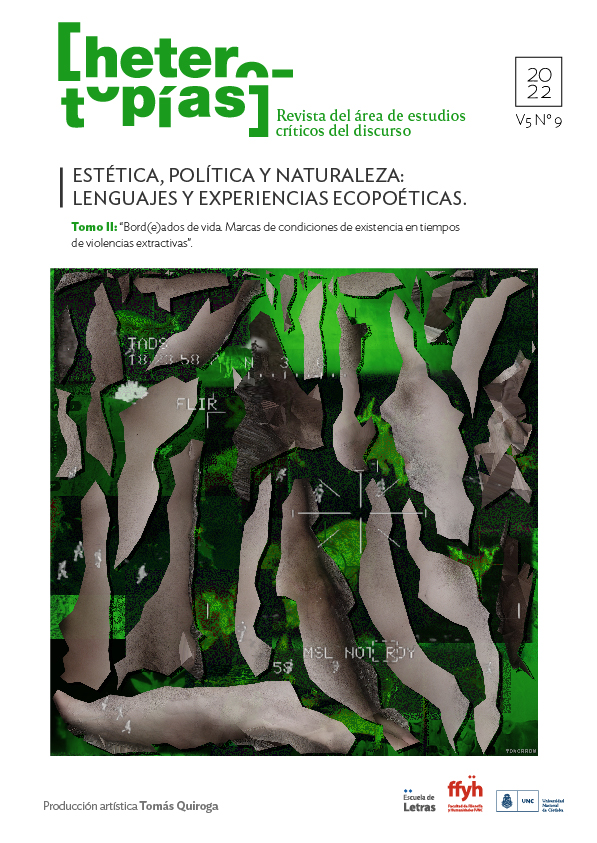Potpourri Semiotic Reflections on Nature and Subject in children's literature
Main Article Content
Abstract
Literary discourses that artistically manifest the link between nature and childhood show different ways to maintain the inclusion of childhood in the aestheticization of nature. The links between the natural and the human are observed as a representation of the social function of art created for children. We introduce concepts that bring us closer to an eco-criticism of literature, in contemporary texts, poetry, literary traditions and the picture book.
Downloads
Article Details

This work is licensed under a Creative Commons Attribution-NonCommercial-ShareAlike 4.0 International License.
Those authors who have publications with this journal, accept the following terms: Those authors who have publications with this journal, accept the following terms:
a. The authors will keep their copyright and guarantee to the journal the right of first publication of their work, which will be simultaneously subject to the Creative Commons Attribution - Non-Commercial - Share Alike (by-nc-sa) Attribution License; no commercial use of the original work or any derivative works is allowed, the distribution of which must be done with a license equal to the one that regulates the original work.
b. Authors may adopt other non-exclusive license agreements for the distribution of the published version of the work (e.g., deposit it in an institutional telematic archive or publish it in a monographic volume) provided that the initial publication in this journal is indicated.
c. Authors are allowed and recommended to disseminate their work through the Internet (e.g. in institutional telematic archives or on their website) before and during the submission process, which may lead to interesting exchanges and increase the number of citations of the published work. (See The effect of open access).
How to Cite
References
Agamben, G. (2003). Homo Sacer. El poder soberano y la nuda vida. Valencia: Pre-textos.
Atak. (2017). El jardín. (Trad. Rafael Spregelburd). Buenos Aires: Niño editor.
Barei, S. (2013). Fronteras naturales /fronteras culturales: nuevos problemas/nuevas teorías. En Tópicos del Seminario, 29, UNAM México. Recuperado de http://www.topicosdelseminario.buap.mx/index.php/topsem/article/view/62
Barthes, R. ([1957] 1999). Mitologías. México: Siglo XXI.
Castoriadis, C. (1975). La institución imaginaria de la sociedad. Barcelona: Tusquets.
Cuesta Abad, J: M. (2001). La escritura del instante. Una poética de la temporalidad. Madri: Akal.
De Sarlo, G. (2017). El despertar de la conciencia ecológica a través de la literatura infantil y juvenil. Didáctica de la literatura y educación medioambiental. Revista Iberoamericana de Ciencia, Tecnología y Sociedad, 12(35), 217-228. Recuperado de http://ojs.revistacts.net/index.php/CTS/article/view/28
Delboy, F. (2017). Soy un jardín. Buenos Aires: Periplo.
Giménez, E. A. y Afonso Estéves, C. (2004). Como agua. Buenos Aires: Del eclipse.
Giménez, E. A. y Afonso Estéves, C. (2016) Justo cuando. Córdoba: Comunicarte. http://dx.doi.org/10.4067/S0718-71812013000200017
Lapoujade, D. (2017). Las existencias menores. Buenos Aires: Cactus.
Lurie, A. (1989). No se lo cuentes a los mayores. Literatura infantil, un espacio subversivo. Madrid: Fundación Germán Sánchez Ruipérez.
Mantilla, L. (2017). El lugar de la infancia en la biopolítica contemporánea. En Mansilla, Stolkiner y MinicelIi. Biopolítica e infancia: niños, niñas e instituciones en el contexto latinoamericano. México: Universidad de Guadalajara.
Martín Vidal, B. (2016). Caperuza. Barcelona: Thule.
Martos Núñez, E. y Martos García, A. (2012). Los imaginarios del agua y sus lecturas pansemióticas. En Revista Álabe, (6), 1-15. Recuperado de www.revistaalabe.com
Merchán-Basabe, J. G. (2019). Estetización y Estética de la Naturaleza. En Pensamiento palabra y obra, (21), 94-111. Recuperado de https://revistas.pedagogica.edu.co/index.php/revistafba/article/download/9467/7023
Orenstein, C. (2002). Caperucita roja al desnudo. Barcelona: Ares y mares.
Ostría González, M. (2010). Notas sobre ecocrítica y poesía chilena. Atenea (Concepción), (502), 181-191.https://dx.doi.org/10.4067/S0718-04622010000200010
Pardo, Z. (2016). Bosques flores y jardines. Locus amoenus y locus horridus en algunas obras de literatura infantil. Pontificia Universidad Javeriana. Colombia. Recuperado de https://www.researchgate.net/publication/343376607_Bosques_flores_y_jardines_Locus_amoenus_y_locus_horridus_en_algunas_obras_de_literatura_infantil_zpardo
Pizarro Clemo, A. (2016). Júbilo. Romance del jardinero. Buenos Aires: Limonero.
Punte, M. J. (2013). El retorno a los bosques encantados: infancia y monstruosidad en ficciones del sur. Aisthesis, (54), 287-301.
Serra, A. (2013). Caperucita Roja. D. F. México: Fondo de Cultura Económica.
Souriau, E. ([1943] 2009) Los diferentes modos de existencia. Buenos Aires: Cactus.
Souriau, E. (1998). Diccionario Akal de estética. Madrid: Akal.
Zipes, F. (2014). El irresistible cuento de hadas Historia cultural y social de un género. México: FCE.
